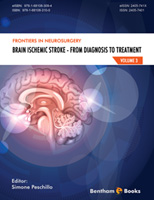Abstract
Stroke represents an important cause of death and permanent disability in the industrialized world. Diagnostic imaging plays a key role in the clinical process, distinguishing, early in the acute phase, ischaemic stroke from primary haemorrhagic stroke. Nowadays, new imaging techniques, such as Computed Tomography Angiography (CTA), Magnetic Resonance Angiography (MRA) and perfusion imaging represents important tools in the definition of the severity of ischaemic stroke. The aim of advanced imaging techniques is to identify cerebral ischaemia within the first few hours and distinguish normal cerebral tissue from that at risk. This chapter focuses on imaging characteristics of stroke, with their anatomic-radiologic correlations, emphasizing the role of new imaging techniques, with their strengths and weaknesses.
Keywords: Brain infarct, Computed Tomography, Computed Tomography Angiography (CTA), CT perfusion (CTP), Ischaemic penumbra, Magnetic Resonance Angiography (MRA), Magnetic Rensonance Imaging, Stroke.






















